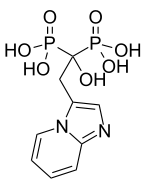Minodronic acid
Minodronic acid is a third-generation bisphosphonate drug. It is approved for use in Japan for the treatment of osteoporosis.[1] Its mechanism of action involves inhibition of farnesyl pyrophosphate synthase activity.[2]
 | |
| Names | |
|---|---|
| IUPAC name
(1-Hydroxy-2-imidazo[1,2-a]pyridin-3-yl-1-phosphonoethyl)phosphonic acid | |
| Other names
Minodronate; YM 529 | |
| Identifiers | |
| |
3D model (JSmol) |
|
| ChEMBL | |
| ChemSpider | |
PubChem CID |
|
| UNII | |
CompTox Dashboard (EPA) |
|
| |
| |
| Properties | |
| C9H12N2O7P2 | |
| Molar mass | 322.150 g·mol−1 |
Except where otherwise noted, data are given for materials in their standard state (at 25 °C [77 °F], 100 kPa). | |
| Infobox references | |
References
- Shridhar Hegde and Michelle Schmidt (2009). "To Market, To Market - 2009. 16. Minodronic acid". Annual Reports in Medicinal Chemistry. 45: 509–510. doi:10.1016/s0065-7743(10)45028-9.
- Sorbera, L.A.; Castañer, J.; Leeson, P.A. (2002). "Minodronic Acid". Drugs of the Future. 27 (10): 935–941. doi:10.1358/dof.2002.027.10.701186.
This article is issued from Wikipedia. The text is licensed under Creative Commons - Attribution - Sharealike. Additional terms may apply for the media files.